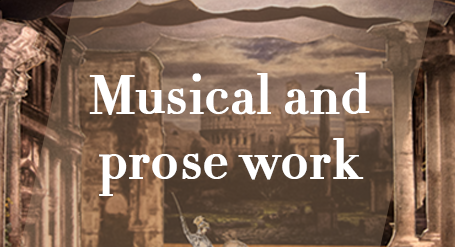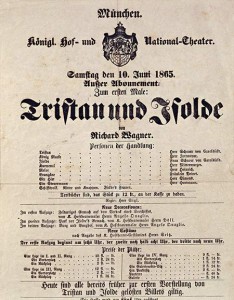
The musical work of Richard Wagner is composed of operas or “musical dramas” ranging from “Fairies” (Die Feen) to “Parsifal”. A detailed presentation of each of these major works is associated here with a set of thematic articles, placing them not only in the context of his personal life but also in his social, economic and cultural context. This section also includes all the musical works (excluding opera) and his literary work.
Tristan and Isolde, WWV90
Tristan und Isolde, WWV90
Music drama in three acts
Libretto and music by Richard Wagner
Premiere :
10th June 1865, Hoftheater Munich
Cast :
TRISTAN a Breton nobleman, adopted heir of Marke
MARKE King of Cornwall (bass)
ISOLDE an Irish princess betrothed to Marke (soprano)
KURWENAL Tristan’s servant (baritone)
MELOT a courtier, Tristan’s friend (tenor or baritone)
BRANGÄNE Isolde’s maid (mezzo-soprano)
A SHEPHERD (tenor)
A STEERSMAN (baritone)
THE VOICE OF A YOUNG SAILOR (tenor)
Ship’s crew, knights and pages (chorus)
The action takes places In a Middle Ages legend, in Cornwall, England and in Brittany, France
Duration : from 3h40 to 4h30 (depending on conductors)
![]()
 Seventh opera by Richard Wagner, Tristan and Isolde (Tristan und Isolde, WWV 90) is the fourth opera created during the so-called maturity phase of the composer and the first conceived under the patronage of King Ludwig II of Bavaria.
Seventh opera by Richard Wagner, Tristan and Isolde (Tristan und Isolde, WWV 90) is the fourth opera created during the so-called maturity phase of the composer and the first conceived under the patronage of King Ludwig II of Bavaria.
It is also the only work derived from a command in the career of the composer: on 9 March, 1857, Wagner received a visit from Dr. Enesto Ferreiro-França, emissary of Emperor Dom Pedro II of Brazil who asked Wagner to compose “an opera in the Italian style” in order to get it performed in Rio de Janeiro. Seduced by this command and attracted, as always through his works, by the project to magnify on stage the power of love, Wagner temporarily abandoned the composition of The Ring of The Nibelung (at that time, he was working on the composition of the second act of Siegfried) as well as his project of The Master-Singers of Nuremberg (Die Meistersinger von Nürnberg), of which he had already woven the main plot.
The libretto of this “musical drama” in three acts is inspired by a traditional Celtic legend dating from the XIIth century. Wagner dived into the many sources relating it: the two versions of Gottfried von Strassburg (1205-1210), the continuations of Ulrich von Türheim (1235) and Heinrich von Freiberg (1280), Sir Tristem in Middle English according to Thomas von Erceldoune, Béroul’s Tristan (1180), the lai The Honeysuckle by Marie de France … However, he only made the real project of Tristan in 1854, primarily thanks to three triggers: reading Schopenhauer’s The World as Will and Representation, meeting Mathilde Wesendonck, and finally the competition initiated by his friend Karl Ritter, who had also been thinking about writing a drama about Tristan. (read more…)
If you wish to share further information about this article, please feel free to contact us !
